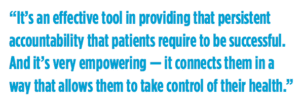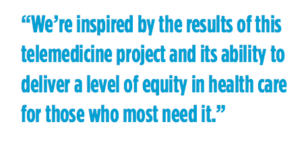Telemedicine pilot funded by JB-LF sees huge successes in its second year
Excerpt from the 2018 annual report
When she was pregnant with her second child, Cora (name changed for privacy) was diagnosed as being at high risk for blood clots, a condition that would require medication and regular check-ins with her doctor to prevent a potentially life-threatening situation. While scary for any mother-to-be, this can be a largely manageable condition — unless your personal and financial circumstances are stacked against you.
Cora doesn’t have health insurance, and her employer threatened to fire her if she missed work. On top of that, she had a deep-seated fear of the treatment being recommended. Faced with a difficult choice between her health and providing for her family, Cora’s skepticism and the financial and time hurdles seemed insurmountable, and she would likely not have started treatment under normal circumstances.
But thanks to an innovative telemedicine program funded by the Jennifer Bush-Lawson Foundation, and the care and persistence of the medical staff at Virginia Hospital Center’s Outpatient Clinic, Cora was able to get the treatment she needed, and she and her baby are healthy and well today as a result.
Launched in mid-2017, the telemedicine pilot was been a win-win-win for the Foundation, the Outpatient Clinic and the women and families that it serves. It all started when the Foundation partnered with the Virginia Hospital Center to figure out how best to use proceeds from our annual 5K benefit race. At that time, the hospital had secured a grant to put the infrastructure in place for a telemedicine program, but did not have funding for the staffing and care coordination it would take to implement it. The Jennifer Bush-Lawson Foundation is proud to have helped this program get off the ground with an initial $83,000 grant, and is now in the second and final year of funding it.
More than 50 patients have benefited so far from the telemedicine program. Like Cora, they are uninsured women who have been identified as having high-risk, but stable, pregnancies — such as diabetes. Once identified as a  good fit for the program, a care coordinator adds the telemedicine software to a patient’s smartphone, gives her a thorough tutorial, and determines how many appointments can be virtual. From then on, patients can check in remotely with their doctors to report blood sugar levels, blood pressure, and other measurements that are easily taken independently at home. (JB-LF also funded blood pressure cuffs to loan to telemedicine patients, as well as transportation vouchers for their required in-office visits.)
good fit for the program, a care coordinator adds the telemedicine software to a patient’s smartphone, gives her a thorough tutorial, and determines how many appointments can be virtual. From then on, patients can check in remotely with their doctors to report blood sugar levels, blood pressure, and other measurements that are easily taken independently at home. (JB-LF also funded blood pressure cuffs to loan to telemedicine patients, as well as transportation vouchers for their required in-office visits.)
“It’s an effective tool in providing that persistent accountability that patients require to be successful,” says Lesley Daigle, telemedicine coordinator for the Outpatient Clinic. “And it’s very empowering — it connects them in a way that allows them to take control of their health.”
The telemedicine program has been successful on a number of fronts. Just over a year into it, the clinic saw a 13 percent reduction in primary C-section rates and a 38 percent reduction in NICU admissions. ER and hospital admissions have also declined among telemedicine patients.
With such successful outcomes, the hospital has absorbed the nursing and care coordination into its permanent staff and budget, and plans to expand telemedicine to Arlington Pediatric Center. From a business standpoint, telemedicine offers efficiencies over in-person appointments, and the residents who staff the clinic are enhancing their qualifications with this cutting-edge technological experience.
“This really is the future of medicine,” says Michelle Altman, patient care  director of the Outpatient Clinic.
director of the Outpatient Clinic.
But the main goal of the program has always been to increase access to care, a mission shared by the Foundation, and that has been achieved. In Cora’s case, the human factor made all the difference — it took some time for the nursing staff to convince her to get on board with the medication and the program. Once they succeeded, Cora was able to connect with her doctors weekly from a closet at work.
“If we’re able to connect with patients, we’re preventing an ER visit,” says Altman. “We’re addressing the health issues of patients before they become chronic and keeping their babies inside healthy and happy. Empowering patients to take the initiative and be involved in their care is not something this population always feels or has.”
Added JB-LF founder and chair Neal Lawson: “We’re inspired by the results of this telemedicine project and its ability to deliver a level of equity in health care for those who most need it.”
